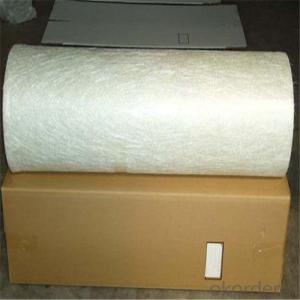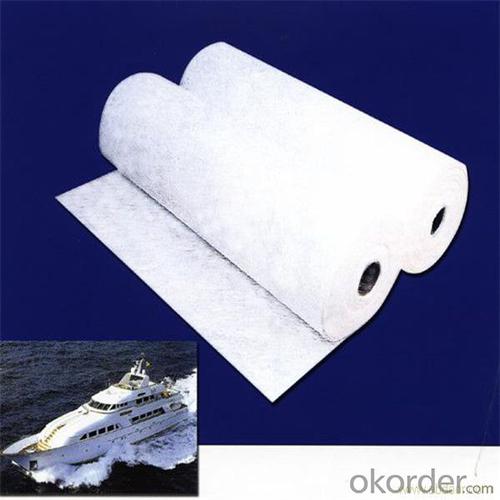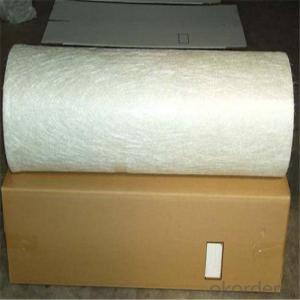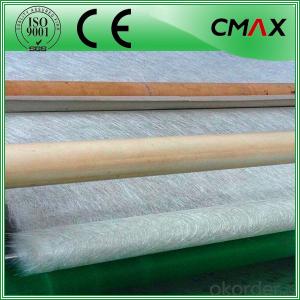Chopped Strand Fiberglass for Sale - Chopped Stand Mat for Fiberglass Boat Parts
- Loading Port:
- Tianjin
- Payment Terms:
- TT OR LC
- Min Order Qty:
- 100 m.t.
- Supply Capability:
- 20000 m.t./month
OKorder Service Pledge
Quality Product, Order Online Tracking, Timely Delivery
OKorder Financial Service
Credit Rating, Credit Services, Credit Purchasing
You Might Also Like
Quick Details
| Technique: | Chopped Strand Fiberglass Mat (CSM) | Dimensions: | 450gsm | Mat Type: | Continuous Filament Mat |
| Fiberglass Type: | E-Glass | Softness: | softness | Place of Origin: | Jiangxi, China (Mainland) |
| Brand Name: | cnbm | Model Number: | 450gsm | color: | white |
| fiberglass type: | E glass | product: | e-glass powder chopped stand mats | binder: | powder or emulsion |
| width: | 1040 or 1270mm, as your requirement | weight: | 30 or 45kg/roll | paper tube diameter: | 90mm |
| outer diameter of roll: | 256mm | packing: | plastic film+carton box + pallet |
Packaging & Delivery
| Packaging Details: | plastic film+carton box + pallet |
| Delivery Detail: | 15-20days |
Specifications
1.e-glass powder chopped stand mats
2.binder:power or emulsion
3.width:1040mm or 1270mm
4.weight:450gsm
Picture

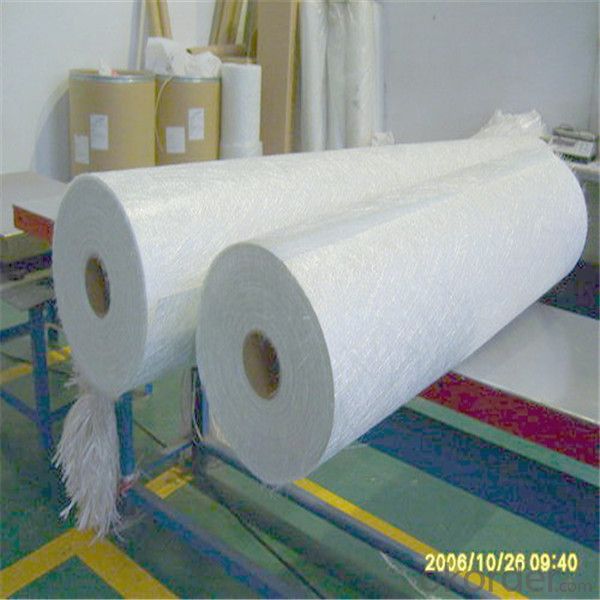




- Q: How does the fiber-to-resin adhesion affect the properties of chopped strand composites?
- The fiber-to-resin adhesion is crucial in determining the properties of chopped strand composites. A strong adhesion between the fibers and the resin matrix enhances the overall strength, stiffness, and durability of the composite material. It helps in efficiently transferring load between the fibers and the resin, leading to improved mechanical properties and resistance to impact, fatigue, and creep. Additionally, a good adhesion ensures better stress distribution within the composite, reducing the likelihood of delamination or fiber pull-out. Hence, the fiber-to-resin adhesion plays a significant role in optimizing the performance and reliability of chopped strand composites.
- Q: Can fiberglass chopped strand be used to reinforce concrete?
- Fiberglass chopped strand is capable of reinforcing concrete. By incorporating the chopped strands into concrete mixtures, the concrete gains supplementary tensile strength, impact resistance, and durability. The fiberglass strands function as a reinforcement material, effectively managing cracking and enhancing the overall structural integrity. This proves particularly advantageous in scenarios where concrete may encounter substantial loads or harsh environmental circumstances. Moreover, fiberglass chopped strand is not only lightweight but also resistant to corrosion, rendering it an optimal selection for concrete reinforcement.
- Q: How is fiberglass chopped strand used in the transportation industry?
- Fiberglass chopped strand is widely used in the transportation industry for reinforcing various components. It is commonly used in the manufacturing of automotive parts such as bumpers, hoods, and interior panels. The chopped strands are typically mixed with resin to create a composite material that offers strength, durability, and lightweight properties. This enables the production of lighter vehicles, improving fuel efficiency and reducing emissions. Additionally, fiberglass chopped strand is also used in the construction of boats, airplanes, and other transportation modes to enhance their structural integrity and performance.
- Q: How is the surface treatment of fiberglass chopped strand done?
- The surface treatment of fiberglass chopped strand is typically done through a process called silane treatment. Silane is a chemical compound that is applied to the surface of the glass fibers. It acts as a coupling agent, bonding the glass fibers to the resin matrix in the composite material. The silane treatment involves applying a thin layer of the silane compound to the glass fibers. This is usually done through a spray application or by dipping the fibers into a silane solution. The silane then reacts with the surface of the glass fibers, forming a covalent bond. The purpose of the surface treatment is to improve the compatibility between the glass fibers and the resin matrix. Without the treatment, the glass fibers may not bond well with the resin, leading to reduced strength and performance of the composite material. The silane treatment also helps to enhance the adhesion between the fibers and the resin, improving the overall mechanical properties of the composite. It can also increase the resistance to moisture absorption, making the material more durable and long-lasting. In addition to silane treatment, other surface treatments may also be used for fiberglass chopped strand, depending on the specific application and requirements. These can include coatings, finishes, or sizing agents, which further enhance the bonding between the fibers and the resin matrix. Overall, the surface treatment of fiberglass chopped strand is a critical step in the manufacturing process of composite materials. It ensures proper bonding and improved performance, making the material suitable for a wide range of applications in industries such as automotive, construction, aerospace, and marine.
- Q: Can fiberglass chopped strand be used for reinforcing ceramic materials?
- Yes, fiberglass chopped strand can be used for reinforcing ceramic materials. The high tensile strength and excellent heat resistance of fiberglass make it a suitable reinforcement material for ceramic composites, improving their mechanical properties and durability.
- Q: Can fiberglass chopped strand be recycled?
- Indeed, the recycling of fiberglass chopped strand is possible. Fiberglass, a material with exceptional recyclability, can undergo melting and reshaping to generate fresh products. The recycling procedure entails disintegrating the chopped strand into tinier fragments, isolating it from any accompanying materials or impurities, and subsequently liquefying it to fabricate novel fiberglass items. By recycling fiberglass, waste is diminished, and resources are conserved, rendering it an eco-conscious alternative.
- Q: Can fiberglass chopped strand be used for reinforcing rubber materials?
- Indeed, fiberglass chopped strand is capable of reinforcing rubber materials. It is frequently employed across a range of industries, particularly in the realm of rubber manufacturing. By incorporating it into rubber compounds, the mechanical characteristics of the rubber, such as tensile strength, tear resistance, and dimensional stability, are significantly enhanced. During the compounding process, the fiberglass chopped strand is typically blended with the rubber material, thereby contributing to the overall improvement and endurance of the rubber products. Moreover, the fiberglass chopped strand exhibits exceptional adhesion to rubber, guaranteeing a robust bond between the two substances. Consequently, it serves as a suitable alternative for reinforcing rubber materials.
- Q: Can fiberglass chopped strand be used in the production of automotive grilles?
- Yes, fiberglass chopped strand can be used in the production of automotive grilles. It provides excellent strength, durability, and corrosion resistance, making it a suitable material for this application.
- Q: How does the fire resistance of fiberglass chopped strand compare to other reinforcing materials?
- The fire resistance of fiberglass chopped strand is generally superior to many other reinforcing materials. Its inherent properties allow it to withstand high temperatures and prevent the spread of flames, making it a desirable choice for various applications where fire safety is a concern.
- Q: How is fiberglass chopped strand used in the telecommunications industry?
- Various applications in the telecommunications industry make extensive use of fiberglass chopped strand. The reinforcement of plastic components in communication cables stands out as one of the primary functions of fiberglass chopped strand in this industry. These cables serve the purpose of transmitting data, voice, and video signals over long distances. To create a composite material, a thermoplastic resin, such as polyethylene or polypropylene, is mixed with the fiberglass chopped strand. The resulting composite is then employed in the manufacturing of the outer protective layer or jacket of communication cables. The addition of fiberglass reinforcement enhances the strength and durability of the cables, enabling them to withstand harsh environmental conditions, including extreme temperatures, moisture, and UV radiation. Moreover, the production of fiber optic cables heavily relies on fiberglass chopped strand. These cables are essential for high-speed data transmission and internet connectivity. In fiber optic cables, chopped fiberglass strands are impregnated with a UV-resistant resin and wound around the glass fibers, providing mechanical protection. This reinforcement effectively safeguards the delicate glass fibers, ensuring the dependable and efficient transmission of data signals. Furthermore, the manufacturing of telecommunication equipment, such as antenna radomes, can also incorporate fiberglass chopped strand. Radomes function as protective covers that enclose antennas, guarding them against external elements. By embedding the chopped fiberglass strands in a resin matrix, a lightweight and durable material is created, which offers exceptional electromagnetic transparency. This transparency allows the antennas to transmit and receive signals without interference, thereby ensuring optimal performance. In conclusion, fiberglass chopped strand plays a vital role in the telecommunications industry by reinforcing communication cables, fiber optic cables, and telecommunication equipment. Its exceptional strength, durability, and resistance to environmental factors make it an ideal material for guaranteeing reliable and efficient communication networks.
Send your message to us
Chopped Strand Fiberglass for Sale - Chopped Stand Mat for Fiberglass Boat Parts
- Loading Port:
- Tianjin
- Payment Terms:
- TT OR LC
- Min Order Qty:
- 100 m.t.
- Supply Capability:
- 20000 m.t./month
OKorder Service Pledge
Quality Product, Order Online Tracking, Timely Delivery
OKorder Financial Service
Credit Rating, Credit Services, Credit Purchasing
Similar products
Hot products
Hot Searches
Related keywords


